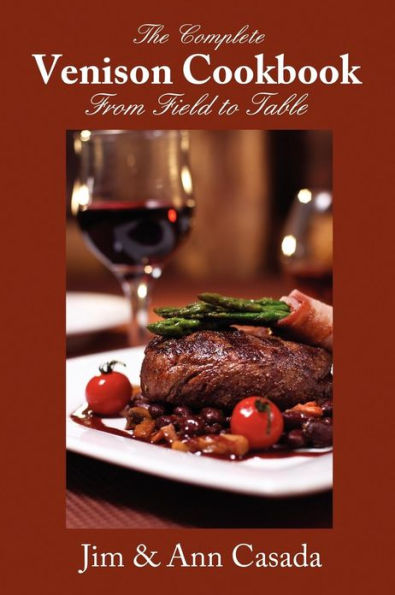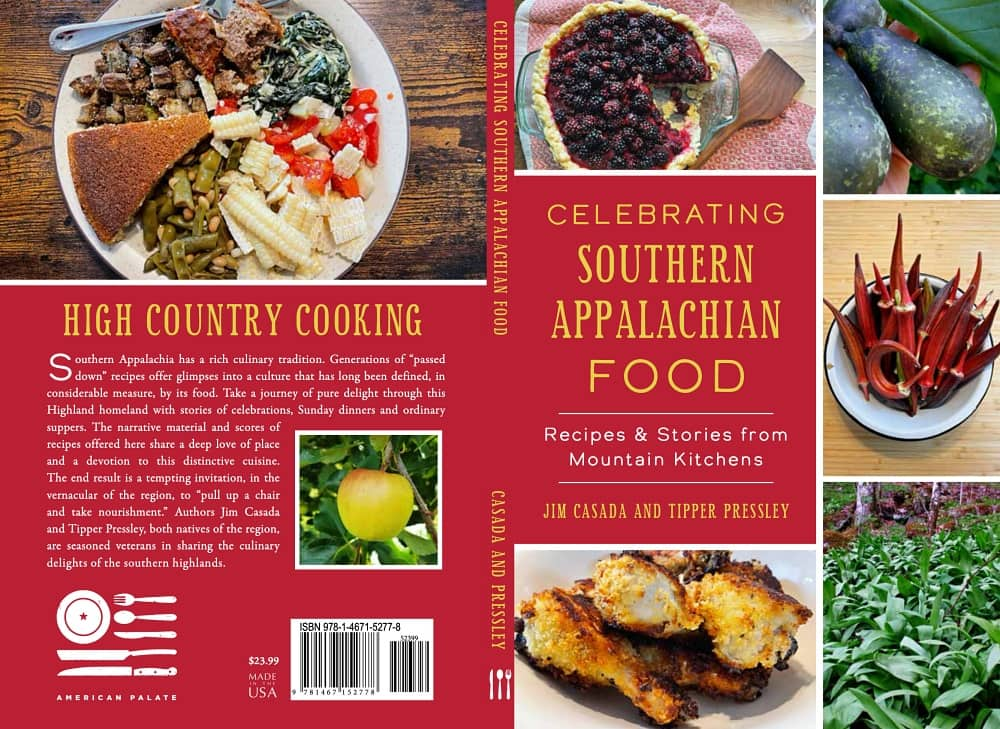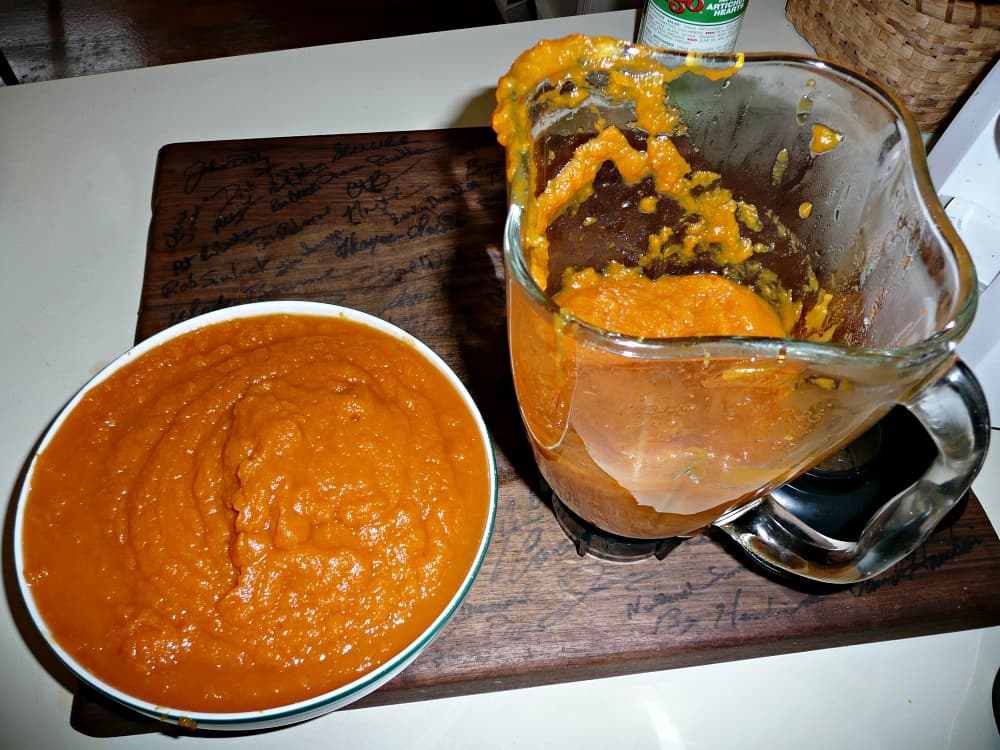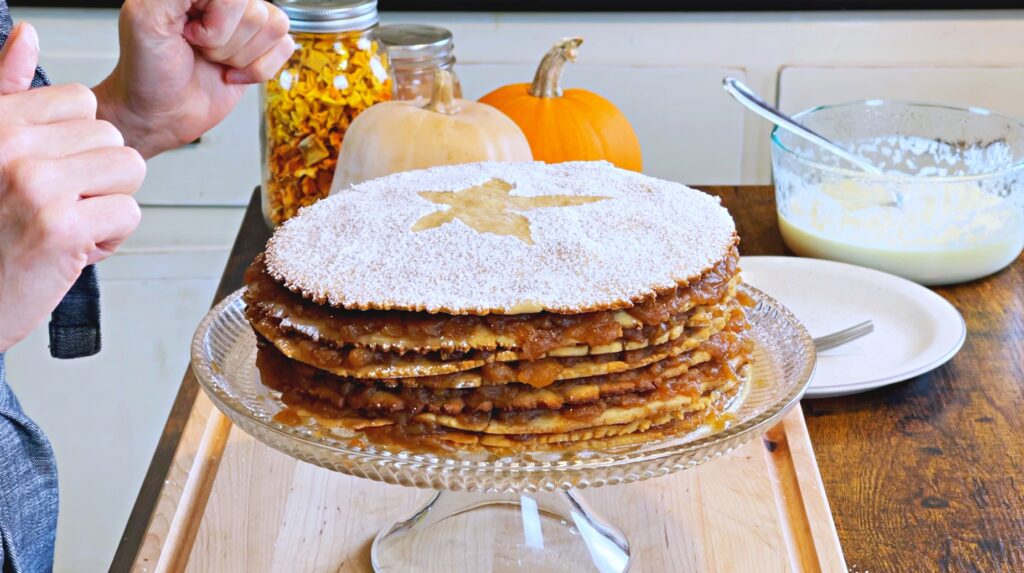NOVEMBER NOSTALGIA—LOOKING BACK WITH LONGING
Since it is seasonally appropriate and focuses squarely on one of the dominant themes of this newsletter, nostalgia, for this month I am offering the text of the newspaper piece which was among my efforts recognized in the 2022 Excellent in Craft award competition by the Southeastern Outdoor Press Association (SEOPA). Full details on my good fortune in the SEOPA competition are provided below under “Jim’s Doin’s”.
THANKSGIVING AS I REMEMBER IT
Of all the major holidays celebrated in the Smokies, I think Thanksgiving has changed the least over the course of my lifetime. It remains much as it was during my boyhood, and for me it is a day when nostalgia reigns supreme. I look back to our family’s annual celebratory feast with loving longing.
Meat formed the central focus of the meal and up until the time I reached the age of twelve or so and Grandpa Joe stopped raising hogs, we enjoyed not one but two meat options. Hog killin’ time normally occurred a week before Thanksgiving. As a result, there might be fried tenderloin for breakfast. Served along with cathead biscuits, sawmill gravy, eggs, grits, and an impressive selection of sweeteners including sourwood honey, molasses, jelly, jam, and a commercial corn syrup known as Dixie Dew, there was fodder aplenty to start the day. It made for a lavish and scrumptious breakfast.
That was welcome because on Thanksgiving the family ate only two meals—a hearty breakfast and the family feast in mid-to-late afternoon. If one got peckish, which was pretty much perpetual for this greedy-gut youngster, there was always a cold biscuit, some leftover cornbread from the previous day, or fried pies. Along with a glass of milk they provided interim sustenance aplenty.
Although store-bought turkey replaced chicken once my paternal grandparents had become too old and feeble to raise their own meat, for many years the centerpiece on the festive holiday table was baked chicken. One chicken wouldn’t suffice, thanks to the size of the gathering. Instead, there would be several chickens, guaranteeing not only plenty for everyone at Thanksgiving but the makings of soup, sandwiches, or chicken and dumplings in the days to come.
Chickens for the table were handled either by wringing their necks or chopping off their heads. There was no room for lollipop sentimentalism when it came to living close to the good earth. You understood the cycle of life and the necessity of death, and the latter was handled in a straightforward, no-nonsense manner.
The way chickens destined for the Thanksgiving table met with the executioner (Grandpa) fascinated me. I understood where meat came from in a manner which probably nine out of ten of today’s youngsters don’t. I may not have been exactly bloodthirsty, but suggesting I took no interest in the dispatching of hogs, chickens, or, for that matter, wild game, would be a decided misrepresentation of reality. I thoroughly enjoyed being part and parcel of the process.
Then it was time to remove entrails, carefully setting aside the giblets for use with gravy and dressing, dunk the carcass in scalding hot water, and pluck the birds. With the birds duly plucked and singed, they were turned over to Grandma Minnie. She would work her kitchen wizardry with the dressed birds, and the mere thought of getting into the middle of one of those baked hens, where miniature yolks of eggs in the making provided a special treat on Thanksgiving Day, still sets my salivary glands in overdrive.
Along with Thanksgiving’s baked hens, there would be splendid arrays of vegetable side dishes, pickles, relishes, and other provender. Standard fare included Aunt Emma’s ambrosia; brimming bowls of leatherbritches and October beans cooked with streaked meat; stewed greens with small cubes of turnips blended in; creamed corn; casseroles featuring sweet potatoes, green beans, and squash; mashed or scalloped potatoes; cranberry relish; a variety of pickles made from cucumbers, beets, watermelon rind, okra, and peaches; chowchow; and more. Along with baked chicken, two other dishes stand out in my mind as truly emblematic of a mountain Thanksgiving.
One was the dressing which served as the standard accompaniment for the chicken and giblet gravy (see recipe below). It was prepared with cornbread made from stone-ground meal, but the key to its distinctiveness involved incorporation of plenty of chopped chestnut meats. Alas, these weren’t the American chestnuts previous generations had known, but instead mast from a Chinese chestnut which grew on our place. To me the sweet, starchy nuts tasted delicious, but Grandpa would often say, with about as much emotion as this hickory-tough old man ever displayed, “they are good but they just ain’t the same.”
The other item which had special appeal was stack cake (see recipe below). It offered one example of many in which Grandma Minnie’s culinary skills came to the forefront. She always made her stack cakes using six or seven thin layers of cake interspersed with applesauce prepared from fruit she had dried in late summer or early fall. The cake would be prepared three or four days in advance, and by the time Thanksgiving rolled around sauce between the layers had soaked into the cake to produce a marriage of indescribably delicious taste. No matter how much I ate before the family moved from the main meal to dessert, there was always room left for a hefty slice of stack cake. Partly for diplomatic reasons but mostly because in those days my innards seemed capable of expansion in a fashion reminiscent of a timber rattler consuming what seemed impossibly large prey, for good measure a slice of Mom’s pumpkin chiffon pie would rest alongside my stack cake.
Year after year women folks worked their collective wonders and brought everything together to a fragrant, delectable finish. The bounty atop the big old dining room table and laden sideboards at my grandparents’ home was a joy to behold. When all was in readiness, the entire family would gather around the food, linking hands in a sense of thankfulness and togetherness.
Then in a voice so soft you had to strain to hear him, Grandpa Joe blessed the feast. He would allude to the harvest, express appreciation for health and another good crop year, and always conclude with “You’uns see what’s before you. Eat hearty.”
Rest assured I did so with great gustatory delight. Looking back, wonderful food memories of those long ago Novembers still fill my mind with thanksgiving.
********************************************************************************
THIS MONTH’S BOOK SPECIALS
Books always make a grand Christmas present because of the way they stand the test of time. The first book I ever owned was a copy of Zane Grey’s Spirit of the Border, chosen by Mom and given to me for Christmas when I was around ten years of age. It still graces a shelf in my study. Here’s a selection of books that I think will, in one fashion or another, offer a fine measure of Yuletide reading pleasure. All are at decidedly advantageous prices. Please take note that you must order these by mail or e-mail and pay with a check, cashier’s check, or money order. My PayPal account is not set up to handle variations from listed prices and, frugal soul that I am, I must also add that PayPal takes a not inconsiderable bit out of one’s financial hide.

Carolina Christmas: Archibald Rutledge’s Enduring Holiday Stories. This anthology combines more than 30 Rutledge holiday tales with extensive commentary I provided, a special section of Yuletide recipes for seasonal foods he mentioned in his writings (my late wife, Ann, and I took his mention of the foodstuffs and provided full instructions on how to prepare each dish). $25 POSTPAID. The book normally sells for $30 and shipping is $5, so you are getting a $10 break.

The Complete Venison Cookbook. One of the bestselling of the books I have done, this effort, again done in company with my late wife, features well over 200 recipes, most of them simple and straightforward, for preparing venison. $14 POSTPAID. The book normally sells for $15, and shipping is $5, so you are getting a $6 break in the price.

Celebrating Southern Appalachian Food: Recipes and Stories from Mountain Kitchens. This is the cookbook Tipper Pressley and I have been working on together. It’s still a few months from publication but a price has been set and a cover selected, so I feel comfortable in offering it pre-publication at the list price and with free shipping. $23.99 will reserve your POSTPAID copy, with mailing to come as soon as the book is in hand.
*******************************************************************************
JIM’S DOIN’S
With Thanksgiving feasting still in the offing, the month of November has already been one of wonder and delight for me. There are several reasons for that. While I know that parents and grandparents talking about the activities of their offspring forms the stuff of cures for insomnia as well as one explanation of why I’m a stranger to Facebook, I’ll nonetheless beg you to indulge me a bit on this front. My granddaughter is in the process of interviewing for enrollment in graduate programs (some masters, others doctoral level) in occupational therapy, and she’s already been accepted into a couple of schools. Her undergraduate work at Presbyterian College has been stellar, and I just have to hope she never inquires about a comparison of her grades (she’s a senior) with mine when I was an undergraduate at King College so many decades ago.
There’s comparable pride in my daughter and her mother (who also attended Presbyterian). She’s moved steadily up the ladder in human resources at KPMG, a major international accounting firm, and is now Executive Director in HR. What pleases me most about both mother and daughter is their stellar work ethic. I have little use for slackers, bums, or lazy folks in general, and the fact that both of them know the importance of diligent application when it comes to dealing with the tasks life places before them gives me great joy. Belief in the sanctity of work was one of my finest legacies from my parents, and I’m powerful proud to be passing it on.

Ryan Coleman, the designer for the book and Jim
In addition to basking a bit in their reflected glory, November has brought me blessings aplenty. First, as these words are being written I have just received news of the arrival of preliminary copies of both the deluxe and regular editions of Lords of the Veldt and Vlei: Africa’s Pioneering Hunters.

I’ll likely be signing copies next week and this is your final chance (offer ends on Thanksgiving Day, November 24) to order copies at list price and get free shipping. The deluxe edition, bound in leather and numbered (total issue of 1000 copies), is $75 and the regular one $45. Payment by check or money order only—no PayPal on this offer.
Then there are the results of the 2022 annual Excellence in Craft competition of the Southeastern Outdoor Press Association. Each year the organization recognizes stellar work through competition in nine categories ranging from books and magazine articles to electronically published stories, newspaper pieces, photographs, and the like. In this year’s competition I fared better than ever before, and I’ve entered my work every year from when I first joined the organization back in the 1980s. When he read a press release covering all of the SEOPA awards, a longtime friend who just happens to be one of the finest outdoor writers I know, Jim Spencer, sent me a congratulatory message that concluded: “Congratulations old man. You’ve still got it.”
I’m not sure just what I’ve still got, but I could give a long list of what I ain’t got including pep in my step, nimbleness, energy, good balance, much hair, acute vision, and the like. On the other hand I’ve got plenty of pounds to spare, a pronounced penchant for a good nap, love of a good book, being perfectly comfortable in long periods of solitude, and some cherished friends like Jim Spencer, crusty curmudgeon though he undoubtedly is (some would place me squarely in the same category). Anyway, here’s a list of my Excellence in Craft recognitions from SEOPA this year on which the “Modern Mountain Man” (Spencer’s moniker) sent congratulations.
ELECTRONIC PUBLISHING STORY
1st place for “Cane Pole Magic” in the Sept. 8, 2021 issue of “Sporting Classics Daily”
2nd place for “The Political Responsibilities of Sportsmen” in the June 1, 2021 issue of “Sporting Classics Daily”
OUTDOOR ENTREPRENEUR PROJECT
2nd place for promotional activities connected with Fishing for Chickens: A Smokies Food Memoir.
NEWSPAPER STORY
2ND place for “Thanksgiving as I Remember It” in the November 25, 2021 issue of the Smoky Mountain Times.
3rd place for “Then vs. Now: Loafer’s Glory” in the July 29, 2021 issue of the Smoky Mountain Times.
MAGAZINE STORY
2nd place for “There Are Strange Things Done in the Springtime Sun” in the Mar./Apr., 2022 issue of Sporting Classics.
Honorable mention for “Baker of the Nile” in the Sept./Oct. issue of Sporting Classics.
One other notable development, and it is touched on in the “Specials” section above, involves progress on the cookbook I am doing with Tipper Pressley. She is, incidentally, responsible for bringing you this monthly newsletter as webmaster. Without her expertise I would be hopelessly lost. Celebrating Southern Appalachian Food is almost ready for the production process. The only hold-up, and it has been a real bugbear, is the indexing. I somehow have been unable to gee-haw with the publisher’s instructions and expectations in index preparation. It seems everything I do indexing wise turns to a disaster, never mind that I’ve done perhaps a dozen of them before. Still, with the help of an extraordinarily patient editor I’ll plow through.
Recent publications include “A Murder as a Mentor: The Strange Saga of Old Al,” “Blind Pig and the Acorn,” Oct. 25, 2022; “Did You Ever?” Smoky Mountain Living, Oct. 1, 2022 (on-line version);
“Going Nuts: The Joys of Autumn Harvest,” Columbia Metro, Nov., 2022, pp. 88-91; and “In Praise of the
Humble Onion,” Smoky Mountain Living, Dec./Jan., 2022-23, pp. 16-19.
I will be speaking on the evening of December 15 at the Birthplace of Country Music Museum in Bristol, TN. My talk will involve storytelling and reminiscing about Christmas in the Smokies with the title being “Yuletide in Yesteryear: Traditional Appalachian Christmas as I Have Known It.” There is no admission and my presentation will be followed by a wine-and-cheese reception, book signing, and opportunity to shake and howdy. If you live in the area and might be interest in attending, contact me (jimcasada@comporium.net) for additional details.
**********************************************************************************
RECIPES
In keeping with the season and the subject of this newsletter’s coverage, all the recipes offered this month are ones that were traditionally associated with Thanksgiving in my highland homeland in the Smokies. Also, it is worth noting that each one of them will appear in the pages of the forthcoming Celebrating Southern Appalachian Food: Recipes and Stories from Mountain Kitchens.
BAKED CHICKEN
Until Grandpa Joe and Grandma Minnie became too old and feeble to raise their own chickens, we always dined on their free-range chickens, as opposed to a store-bought turkey, at Thanksgiving. The recipe below is for a single chicken, but there would always been two or three adorning Grandma’s table. That was necessary because of the size of the family gathering. There would always be a bit of a scramble and argument among the kids to get the ultimate delicacy from those baked hens, little rows of eggs in the making inside the carcass. These were, after all, laying hens that had reached the end of their egg-producing days.
1 whole chicken
1 onion, quartered or chopped roughly
4 carrots, chopped
2 potatoes, quartered or chopped roughly
2 teaspoons paprika
2 teaspoons garlic powder
1 teaspoon onion powder
1 teaspoon oregano
1 teaspoon thyme
1 teaspoon salt
½ teaspoon pepper
1 tablespoon olive oil
½ lemon
1 or 2 rosemary sprigs
Place vegetables on the bottom of a roasting pan or Dutch oven in a single layer. Stir spices together. Path chicken dry and then rub with olive oil. Spread seasonings over the chicken. Place lemon and rosemary in body cavity of the chicken. Cook chicken in 450-degree oven for 15 minutes and then reduce heat for remainder of cooking time to 350 degrees. After the first 15 minutes you will need to cook 20 minutes for each pound of chicken. Since this recipe involves a fair amount of prep and cooking time, you will probably want to choose a large baking hen for use.
TIP: Leftovers can be used in a variety of ways. The chicken soup recipe elsewhere in this chapter is one example.
CHESTNUT DRESSING
Memories of the American chestnut coursed through Grandpa Joe’s mind with the strength born out of deep emotion, and while that one-time giant of Appalachian forests was long gone, we always had a close duplicate come Thanksgiving. That was made possible by a huge Chinese chestnut that grew in our yard and faithfully produced gobs of nuts every fall.
½ cup butter or margarine
1 cup finely chopped celery
1 cup finely chopped onion
1 cup cooked, chopped chestnuts (you can substitute pecans)
6-8 cups cornbread crumbs (homemade is better)
1 egg, beaten
2 (or more) cups chicken or turkey broth
Salt and pepper to taste (those who like sage can add it as well, but keep in mind it has a dominating flavor)
Melt butter in skillet and sauté celery, onion, and nuts. Cook slowly over low heat for 10 minutes; stir frequently as this burns easily. Add to cornbread crumbs in mixing bowl. Add beaten egg and broth, mixing well. Dressing must be VERY moist; add more liquid if needed. Season to taste with salt, pepper and sage (omit sage if you wish, which I do). Bake in casserole dish at 350 degrees for 30 to 45 minutes or until golden brown.
TIP: Leftover dressing is just as tasty as when the preparation has just come from the oven, and it can be reheated for a side dish, adorned with gravy, or mixed with chopped up chicken or turkey and fried as cakes.
PUMPKIN BREAD

Preparing pumpkin
2½ cups sugar
1 cup shortening
3 eggs
15 ounces of pumpkin
3 cups all-purpose flour
1 teaspoon salt
½ teaspoon baking soda
1 teaspoon baking powder
1¼ teaspoons cinnamon
1 teaspoon cloves
1 teaspoon nutmeg
1 teaspoon allspice
1½ cups black walnuts
Combine sugar, eggs, pumpkin, and shortening. In a separate bowl sift together flour, salt, baking soda, baking powder, cinnamon, cloves, nutmeg, and allspice. Combine pumpkin mixture with sifted mixture. Stir in black walnuts. Pour into greased loaf pans and bake for an hour at 350 degrees.
NOTE: Other nuts may be used; pecans are especially good in this recipe.
FRIED PORK TENDERLOIN
Even folks who were squeamish about the actual process of hog killing and the undeniably odiferous, odious work that followed eagerly anticipated the feast of fresh meat that the day offered. For many with lingering links to a vanishing way of life the entire event looms large in nostalgic recollection. Of all the appetizing delicacies provided by fresh pork, for most tenderloin was at the top of the list. Appalachia is full of heartwarming stories of the first mess of fried tenderloin following a day of butchering. Here’s a simple, straightforward way to prepare tenderloin, and for most folks in the region this approach, maybe with slight variations, was what they used.
Flour
Salt
Pepper
Chunks of tenderloin sliced in ½-inch rounds (a thinner or thicker cut may be used)
Mix salt and pepper to taste with the flour. Dredge pork pieces in the flour mixture and fry in hot bacon grease until done. A pan of cathead biscuits and a side of fried apples brings forth the wonderful flavor of the pork in a larger-than-life fashion.
TIP: This recipe works fine with store-bought pork tenderloin but nothing quite matches the fresh option.
CHICKEN STEW
There were always leftovers aplenty from the baked chickens that formed the centerpiece of Thanksgiving feasts, and those leavin’s were perfect for soups and stews. Chicken soup is associated with being a bit under the weather for good reason. It’s nutritious, tasty, filling, and somehow seems just the thing for when, as my Grandpa Joe would have put it, “a body is ailing a bit.” Curiously though, I don’t remember Grandma Minnie, ever making chicken soup or indeed soup of any kind, although her stews, laced with meat and vegetables swimming in gravy, were in essence just thickened soups.
This recipe is similar to the manner in which she prepared chicken stew. She usually did so when there were a couple of leftover carcasses from baked hens served at holidays (we almost always had hens the family had grown as opposed to store-bought turkey) or when an old hen had been sufficiently derelict in her egg-laying duties to invite consumption. Such stews, never mind whether there was illness or not, made a great wintertime dish, especially when a heaping platter of cathead biscuits was served as a side.
1 or 2 whole baked hens or a turkey carcass with ample leftover meat scraps
1 large onion, peeled and quartered
4 ribs celery with leaves, chopped
1 large carrot, scrubbed and cut into chunks
2 whole cloves garlic
1 bay leaf
Water to cover
Remove skin from the carcass. Place in a stock pot and surround with onion, celery, carrot, garlic and bay leaf. Cover with water and bring to a boil. Reduce heat and simmer, covered, for two hours. Refrigerate stock and remove fat which accumulates on the top. Remove all meat from bones and save.
8 cups stock (add canned chicken broth if needed)
2 cups milk
4 medium potatoes, peeled and diced
3 carrots, peeled and diced
3 ribs celery, diced
1 cup frozen or canned lima beans
2 ounces small shell pasta
2 cups fresh, chopped spinach
1 cup frozen green peas
Meat from carcass
¼ cup fresh parsley
½ teaspoon dried basil
1 teaspoon fresh black pepper
Salt to taste
1 cup evaporated milk
2 tablespoons flour mixed with 4 tablespoons water (optional if you want a thicker stew)
Cook stock, milk, potatoes, carrots and celery for a half hour. Add lima beans, pasta, spinach, peas, meat, parsley, basil and pepper to the soup and cook an additional 20 minutes. Remove from heat, season with salt if necessary, and stir in evaporated milk. Return to low heat, stirring often. Do not let stew boil. Thicken with a flour and water paste if desired.
12 hearty servings
TIP: Vegetables other than those mentioned, such as green beans or corn, can be used.
APPLE STACK CAKE

As has been noted, Grandma Minnie always had a stack cake for Thanksgiving, and along with it would be Mom’s pumpkin chiffon pie, Aunt Emma’s orange slice cake, and other sweets in the form of cookies, fried pies, and the like. For me though, stack cake held pride of place. I have no idea about the precise ingredients involved in Grandma Minnie’s stack cake, because she never cooked from any written recipe. Everything was stored in a mind filled with a lifetime of culinary experiences. In fact, other than being indescribably delicious, the only specific I recall about her stack cakes involves the fact that there were always seven layers. That was presumably because seven was considered a lucky number. The recipe below is from Tipper, and I have no doubt it is quite close to the steps and ingredients Grandma Minnie used.
PART 1–CAKE
½ cup shortening
½ cup sugar
1 egg beaten
⅓ cup sorghum syrup
½ cup buttermilk
3½ cups all-purpose flour
½ teaspoon soda
½ teaspoon salt
1 teaspoon ginger
1 teaspoon vanilla
Cream together sugar and shortening. Add egg, sorghum, vanilla, and buttermilk, mix well. Sift together flour, soda, salt, and ginger. Make a hole in dry ingredients, add creamed mixture and stir until the consistency is like soft cookie dough. The next step is making the cake layers. Divide dough into 7 equal parts. You’ll need to add additional flour as you roll out the dough to make the layers. Roll each layer into a 9-inch circle. Bake layers at 350 degrees for 10 to 12 minutes or until light brown around the edges. Set cooked layers aside to cool.
PART 2—APPLE FILLING
1 pound of dried apples (14 cups of dried apples)
Water
1 cup brown sugar
½ cup white sugar
1 teaspoon cinnamon
¼ teaspoon cloves
½ teaspoon allspice
Put apples in a pot with water and cook; keep a fairly close eye on the apples as you may have to add additional water while they cook. Once apples are soft enough to mash, add the other ingredients and mix well.
PART 3: ASSEMBLY
Place a cake layer on a cake plate and spread with apple filling. Repeat until you reach the last layer. Whether you put apple filling on the top layer is up to you. Many cooks use cooked apples to frost the entire cake. I like to leave the top layer bare and sprinkle powdered sugar on it in a pretty shape. This should not be done until just before serving; otherwise the powdered sugar will just soak in and not provide the lovely dusted appearance. Allow cake to sit overnight before eating. This enables the apple goodness to soak fully into the cake layers.
PART 4: CUSTARD SAUCE
4 egg yolks
½ cup sugar
2 cups half and half
1 teaspoon vanilla
pinch of salt
Custard sauce is not part of the traditional apple stack cake recipe, however in my opinion it makes a good thing an even better thing. To make the sauce: Beat yolks in a metal bowl that will fit over a saucepan in the manner of a double boiler. As you beat the yolks, add sugar a little at a time. Once sugar is added, increase the mixer speed scraping bowl as needed and beat until mixture is thick and lemon colored. Add half and half and mix well. Move bowl over saucepan of simmering water. Cook custard over water stirring often until mixture is thick enough to coat the back of a spoon. Add vanilla and salt. Remove from heat and cool before serving. This is a thin custard, which makes it perfect for pouring over a piece of cake.
PART 5: EAT
After the apple stack cake has sat overnight slice a piece and drizzle custard over it or under it or don’t drizzle custard over it or under it at all and eat!
NOTE: If you end up with more layers or less the cake will still be amazingly good! Also, while dried apples form the traditional filling between layers in stack cakes, various jams or reconstituted dried peaches will also work perfectly well.